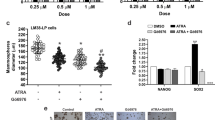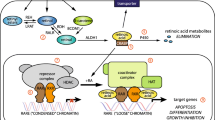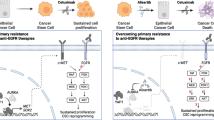Abstract
A large number of studies have investigated possible drug resistance mechanisms of cancer cells and suggested strategies to overcome it. In this review, we outline the role and function of aldehyde dehydrogenase (ALDH) activity in multiple cellular functions and in cancer stem cells (CSCs) and focus on the role of retinoic acid (RA), one of the products of ALDH isozymes. We discuss our observation that ATRA and other RAs can suppress ALDH activity and decrease different ALDH isozyme proteins and result in detrimental effects on cell proliferation, invasion and chemotherapy sensitivity. We review the known uses of different RAs in the treatment of cancers. We review the use of RAs in combination with chemo-/radiotherapy and the major signaling pathways affected in different tumor types. We provide follow-up on studies that may have used our prior observation with the aim of targeting the CSCs. We conclude with summary of the findings and potential impact of published studies on future use of RAs in the targeting of CSCs and drug resistance.
Similar content being viewed by others
References
Jackson B, Brocker C, Thompson DC et al (2011) Update on the aldehyde dehydrogenase gene (ALDH) superfamily. Hum Genom 5:283–303
Vasiliou V, Nebert DW (2005) Analysis and update of the human aldehyde dehydrogenase (ALDH) gene family. Hum Genom 2:138–143
Sladek NE (2003) Human aldehyde dehydrogenases: potential pathological, pharmacological, and toxicological impact. J Biochem Mol Toxicol 17:7–23
Marchitti SA, Brocker C, Stagos D, Vasiliou V (2008) Non-P450 aldehyde oxidizing enzymes: the aldehyde dehydrogenase superfamily. Expert Opin Drug Metab Toxicol 4:697–720
Ma I, Allan AL (2011) The role of human aldehyde dehydrogenase in normal and cancer stem cells. Stem Cell Rev 7:292–306
Moreb JS, Gabr A, Vartikar GR et al (2005) Retinoic acid down-regulates aldehyde dehydrogenase and increases cytotoxicity of 4-hydroperoxycyclophosphamide and acetaldehyde. J Pharmacol Exp Ther 312:339–345
Moreb JS, Mohuczy D, Ostmark B, Zucali JR (2007) RNAi-mediated knockdown of aldehyde dehydrogenase class-1A1 and class-3A1 is specific and reveals that each contributes equally to the resistance against 4-hydroperoxycyclophosphamide. Cancer Chemother Pharmacol 59:127–136
Napoli JL (1996) Retinoic acid biosynthesis and metabolism. FASEB J 10:993–1001
Ross AC (1993) Cellular metabolism and activation of retinoids: roles of cellular retinoid-binding proteins. FASEB J 7:317–327
Kedishvili NY (2013) Enzymology of retinoic acid biosynthesis and degradation. J Lipid Res 54:1744–1760
Tyagi S, Gupta P, Saini AS et al (2011) The peroxisome proliferator-activated receptor: a family of nuclear receptors role in various diseases. J Adv Pharm Technol Res 2:236–240
Germain P, Chambon P, Eichele G et al (2006) International union of pharmacology. LXIII. Retinoid X receptors. Pharmacol Rev 58:712–725
Mongan NP, Gudas LJ (2007) Diverse actions of retinoid receptors in cancer prevention and treatment. Differentiation 75:853–870
Tang XH, Gudas LJ (2011) Retinoids, retinoic acid receptors, and cancer. Annu Rev Pathol 6:345–364
Doldo E, Costanza G, Agostinelli S et al (2015) Vitamin A, cancer treatment and prevention: the new role of cellular retinol binding proteins. Biomed Res Int 2015:624627
Bushue N, Wan YJ (2010) Retinoid pathway and cancer therapeutics. Adv Drug Deliv Rev 62:1285–1298
Shinagawa K, Yanada M, Sakura T et al (2014) Tamibarotene as maintenance therapy for acute promyelocytic leukemia: results from a randomized controlled trial. J Clin Oncol 32:3729–3735
Sanford D, Lo-Coco F, Sanz MA et al (2015) Tamibarotene in patients with acute promyelocytic leukaemia relapsing after treatment with all-trans retinoic acid and arsenic trioxide. Br J Haematol 171:471–477
Ghiaur G, Gerber J, Jones RJ (2012) Concise review: cancer stem cells and minimal residual disease. Stem Cells 30:89–93
Zhao J (2016) Cancer stem cells and chemoresistance: the smartest survives the raid. Pharmacol Ther 160:145–158
Reya T, Morrison SJ, Clarke MF, Weissman IL (2001) Stem cells, cancer, and cancer stem cells. Nature 414:105–111
Moreb JS, Zucali JR, Ostmark B, Benson NA (2007) Heterogeneity of aldehyde dehydrogenase expression in lung cancer cell lines is revealed by Aldefluor flow cytometry-based assay. Cytometry B Clin Cytom 72:281–289
Moreb JS (2008) Aldehyde dehydrogenase as a marker for stem cells. Curr Stem Cell Res Ther 3:237–246
Lobo NA, Shimono Y, Qian D, Clarke MF (2007) The biology of cancer stem cells. Annu Rev Cell Dev Biol 23:675–699
Cheung AM, Wan TS, Leung JC et al (2007) Aldehyde dehydrogenase activity in leukemic blasts defines a subgroup of acute myeloid leukemia with adverse prognosis and superior NOD/SCID engrafting potential. Leukemia 21:1423–1430
Ginestier C, Hur MH, Charafe-Jauffret E et al (2007) ALDH1 is a marker of normal and malignant human mammary stem cells and a predictor of poor clinical outcome. Cell Stem Cell 1:555–567
Silva IA, Bai S, McLean K et al (2011) Aldehyde dehydrogenase in combination with CD133 defines angiogenic ovarian cancer stem cells that portend poor patient survival. Cancer Res 71:3991–4001
Cojoc M, Peitzsch C, Kurth I et al (2015) Aldehyde dehydrogenase Is regulated by beta-catenin/TCF and promotes radioresistance in prostate cancer progenitor cells. Cancer Res 75:1482–1494
Warrier S, Bhuvanalakshmi G, Arfuso F et al (2014) Cancer stem-like cells from head and neck cancers are chemosensitized by the Wnt antagonist, sFRP4, by inducing apoptosis, decreasing stemness, drug resistance and epithelial to mesenchymal transition. Cancer Gene Ther 21:381–388
Kim SK, Kim H, Lee DH et al (2013) Reversing the intractable nature of pancreatic cancer by selectively targeting ALDH-high, therapy-resistant cancer cells. PLoS ONE 8:e78130
Suresh R, Ali S, Ahmad A et al (2016) The role of cancer stem cells in recurrent and drug-resistant lung cancer. Adv Exp Med Biol 890:57–74
Ucar D, Cogle CR, Zucali JR et al (2009) Aldehyde dehydrogenase activity as a functional marker for lung cancer. Chem Biol Interact 178:48–55
Cherciu I, Bărbălan A, Pirici D et al (2014) Stem cells, colorectal cancer and cancer stem cell markers correlations. Curr Health Sci J 40:153–161
Matsui W, Wang Q, Barber JP et al (2008) Clonogenic multiple myeloma progenitors, stem cell properties, and drug resistance. Cancer Res 68:190–197
Greco N, Schott T, Mu X et al (2014) ALDH activity correlates with metastatic potential in primary sarcomas of bone. J Cancer Ther 5:331–338
Januchowski R, Wojtowicz K, Zabel M (2013) The role of aldehyde dehydrogenase (ALDH) in cancer drug resistance. Biomed Pharmacother 67:669–680
Xu X, Chai S, Wang P et al (2015) Aldehyde dehydrogenases and cancer stem cells. Cancer Lett 369:50–57
Moreb JS, Ucar D, Han S et al (2012) The enzymatic activity of human aldehyde dehydrogenases 1A2 and 2 (ALDH1A2 and ALDH2) is detected by Aldefluor, inhibited by diethylaminobenzaldehyde and has significant effects on cell proliferation and drug resistance. Chem Biol Interact 195:52–60
Bertrand G, Maalouf M, Boivin A et al (2014) Targeting head and neck cancer stem cells to overcome resistance to photon and carbon ion radiation. Stem Cell Rev 10:114–126
Mizuno T, Suzuki N, Makino H et al (2015) Cancer stem-like cells of ovarian clear cell carcinoma are enriched in the ALDH-high population associated with an accelerated scavenging system in reactive oxygen species. Gynecol Oncol 137:299–305
Pors K, Moreb JS (2014) Aldehyde dehydrogenases in cancer: an opportunity for biomarker and drug development? Drug Discov Today 19:1953–1963
Koppaka V, Thompson DC, Chen Y et al (2012) Aldehyde dehydrogenase inhibitors: a comprehensive review of the pharmacology, mechanism of action, substrate specificity, and clinical application. Pharmacol Rev 64:520–539
Chapman MS (2012) Vitamin a: history, current uses, and controversies. Semin Cutan Med Surg 31:11–16
Huang ME, Ye YC, Chen SR et al (1988) Use of all-trans retinoic acid in the treatment of acute promyelocytic leukemia. Blood 72:567–572
Cicconi L, Lo-Coco F (2016) Current management of newly diagnosed acute promyelocytic leukemia. Ann Oncol 27:1474–1481
Matthay KK, Villablanca JG, Seeger RC et al (1999) Treatment of high-risk neuroblastoma with intensive chemotherapy, radiotherapy, autologous bone marrow transplantation, and 13-cis-retinoic acid. Children’s Cancer Group. N Engl J Med 341:1165–1173
Masetti R, Biagi C, Zama D et al (2012) Retinoids in pediatric onco-hematology: the model of acute promyelocytic leukemia and neuroblastoma. Adv Ther 29:747–762
Yu AL, Gilman AL, Ozkaynak MF et al (2010) Anti-GD2 antibody with GM-CSF, interleukin-2, and isotretinoin for neuroblastoma. N Engl J Med 363:1324–1334
Walmsley S, Northfelt DW, Melosky B et al (1999) Treatment of AIDS-related cutaneous Kaposi’s sarcoma with topical alitretinoin (9-cis-retinoic acid) gel. Panretin Gel North American Study Group. J Acquir Immune Defic Syndr 22:235–246
Duvic M, Hymes K, Heald P, Bexarotene Worldwide Study Group et al (2001) Bexarotene is effective and safe for treatment of refractory advanced-stage cutaneous T-cell lymphoma: multinational phase II–III trial results. J Clin Oncol 19:2456–2471
Heald P, Mehlmauer M, Martin AG, Worldwide Bexarotene Study Group et al (2003) Topical bexarotene therapy for patients with refractory or persistent early-stage cutaneous T-cell lymphoma: results of the phase III clinical trial. J Am Acad Dermatol 49:801–815
Young MJ, Wu YH, Chiu WT et al (2015) All-trans retinoic acid downregulates ALDH1-mediated stemness and inhibits tumour formation in ovarian cancer cells. Carcinogenesis 36:498–507
Whitworth JM, Londoño-Joshi AI, Sellers JC et al (2012) The impact of novel retinoids in combination with platinum chemotherapy on ovarian cancer stem cells. Gynecol Oncol 125:226–230
Nguyen PH, Giraud J, Staedel C et al (2016) All-trans retinoic acid targets gastric cancer stem cells and inhibits patient-derived gastric carcinoma tumor growth. Oncogene 35:5619–5628
Kawano Y, Kikukawa Y, Fujiwara S et al (2013) Hypoxia reduces CD138 expression and induces an immature and stem cell-like transcriptional program in myeloma cells. Int J Oncol 43:1809–1816
Croker AK, Allan AL (2012) Inhibition of aldehyde dehydrogenase (ALDH) activity reduces chemotherapy and radiation resistance of stem-like ALDHhiCD44+ human breast cancer cells. Breast Cancer Res Treat 133:75–87
Yan Y, Li Z, Xu X et al (2016) All-trans retinoic acids induce differentiation and sensitize a radioresistant breast cancer cells to chemotherapy. BMC Complement Altern Med 16:113
Ma HS, Greenblatt SM, Shirley CM et al (2016) All-trans retinoic acid synergizes with FLT3 inhibition to eliminate FLT3/ITD+ leukemia stem cells in vitro and in vivo. Blood 127:2867–2878
Moro M, Bertolini G, Pastorino U et al (2015) Combination treatment with all-trans retinoic acid prevents cisplatin-induced enrichment of CD133+ tumor-initiating cells and reveals heterogeneity of cancer stem cell compartment in lung cancer. J Thorac Oncol 10:1027–1036
Akie K, Dosaka-Akita H, Murakami A, Kawakami Y (2000) A combination treatment of c-myc antisense DNA with all-trans-retinoic acid inhibits cell proliferation by downregulating c-myc expression in small cell lung cancer. Antisense Nucleic Acid Drug Dev 10:243–249
Ruotsalainen T, Halme M, Isokangas OP et al (2000) Interferon-alpha and 13-cis-retinoic acid as maintenance therapy after high-dose combination chemotherapy with growth factor support for small cell lung cancer–a feasibility study. Anticancer Drugs 11:101–108
De los Santos M, Zambrano A, Aranda A (2007) Combined effects of retinoic acid and histone deacetylase inhibitors on human neuroblastoma SH-SY5Y cells. Mol Cancer Ther 6:1425–1432
Schmoch T, Gal Z, Mock A et al (2016) Combined treatment of ATRA with epigenetic drugs increases aggressiveness of glioma xenografts. Anticancer Res 36:1489–1496
Tosi P, Pellacani A, Visani G et al (1999) In vitro treatment with retinoids decreases bcl-2 protein expression and enhances dexamethasone-induced cytotoxicity and apoptosis in multiple myeloma cells. Eur J Haematol 62:143–148
Ramsingh G, Westervelt P, McBride A et al (2014) Phase I study of cladribine, cytarabine, granulocyte colony stimulating factor (CLAG regimen) and midostaurin and all-trans retinoic acid in relapsed/refractory AML. Int J Hematol 99:272–278
Reynolds CP, Matthay KK, Villablanca JG, Maurer BJ (2003) Retinoid therapy of high-risk neuroblastoma. Cancer Lett 197:185–192
Dhandapani L, Yue P, Ramalingam SS, Khuri FR, Sun SY (2011) Retinoic acid enhances TRAIL-induced apoptosis in cancer cells by upregulating TRAIL receptor 1 expression. Cancer Res 71:5245–5254
Raffoux E, Cras A, Recher C et al (2010) Phase 2 clinical trial of 5-azacitidine, valproic acid, and all-trans retinoic acid in patients with high-risk acute myeloid leukemia or myelodysplastic syndrome. Oncotarget 1:34–42
Bryan M, Pulte ED, Toomey KC et al (2011) A pilot phase II trial of all-trans retinoic acid (Vesanoid) and paclitaxel (Taxol) in patients with recurrent or metastatic breast cancer. Invest New Drugs 29:1482–1487
Arrieta O, González-De la Rosa CH, Aréchaga-Ocampo E et al (2010) Randomized phase II trial of All-trans-retinoic acid with chemotherapy based on paclitaxel and cisplatin as first-line treatment in patients with advanced non-small-cell lung cancer. J Clin Oncol 28:3463–3471
Burnett AK, Hills RK, Green C et al (2010) The impact on outcome of the addition of all-trans retinoic acid to intensive chemotherapy in younger patients with nonacute promyelocytic acute myeloid leukemia: overall results and results in genotypic subgroups defined by mutations in NPM1, FLT3, and CEBPA. Blood 115:948–956
Mu X, Patel S, Mektepbayeva D et al (2015) Retinal targets ALDH positive cancer stem cell and alters the phenotype of highly metastatic osteosarcoma cells. Sarcoma 2015:784954
Author information
Authors and Affiliations
Corresponding author
Ethics declarations
Conflict of interest
The authors have no conflict of interest to declare.
Rights and permissions
About this article
Cite this article
Moreb, J.S., Ucar-Bilyeu, D.A. & Khan, A. Use of retinoic acid/aldehyde dehydrogenase pathway as potential targeted therapy against cancer stem cells. Cancer Chemother Pharmacol 79, 295–301 (2017). https://doi.org/10.1007/s00280-016-3213-5
Received:
Accepted:
Published:
Issue Date:
DOI: https://doi.org/10.1007/s00280-016-3213-5




